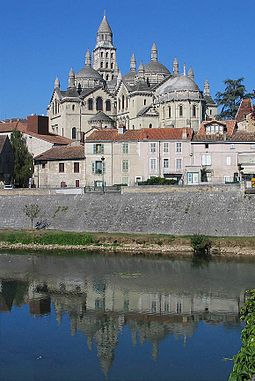Bishop of Périgueux
|
Diocese of Périgueux and Sarlat Dioecesis Petrocoricensis et Sarlatensis Diocèse de Périgueux et Sarlat |
|
|---|---|

|
|
| Location | |
| Country | |
| Ecclesiastical province | Bordeaux |
| Metropolitan | Archdiocese of Bordeaux |
| Statistics | |
| Area | 9,060 km2 (3,500 sq mi) |
| Population - Total - Catholics |
(as of 2013) 412,082 355,900 (86.4%) |
| Information | |
| Denomination | Roman Catholic |
| Sui iuris church | Latin Church |
| Rite | Roman Rite |
| Established | 3rd Century |
| Cathedral | Cathedral Basilica of St. Front in Périgueux |
| Patron saint | Saint Front |
| Current leadership | |
| Pope | Francis |
| Bishop | Michel Mouïsse |
| Metropolitan Archbishop | Cardinal Jean-Pierre Ricard |
| Emeritus Bishops | Gaston Élie Poulain Bishop Emeritus (1988–2004) |
| Map | |
 |
|
| Website | |
| Website of the Diocese | |
The Roman Catholic Diocese of Périgueux and Sarlat (Latin: Dioecesis Petrocoricensis et Sarlatensis; French: Diocèse de Périgueux et Sarlat) is a diocese of the Latin Rite of the Roman Catholic church, in France. The see is located in the city of Périgueux, in the department of Dordogne, in the Region of Aquitaine. The diocese forms part of the ecclesiastical province of Bordeaux, and the current Bishop is Michel Pierre Marie Mouïsse, appointed in 2004.
The Martyrology of Ado gives St. Front as the first Bishop of Périgueux; Saint Peter is said to have sent him to this town with the St. George to whom later traditions assign the foundation of the church of Le Puy. Subsequent biographies, which appeared between the 10th and 13th centuries, make St. Front's life one with that of St. Fronto of Nitria, thereby giving it an Egyptian colouring. At all events we know by the Chronicle of Sulpicius Severus that a Bishop of Périgueux, Paternus, was deposed for heresy about 361.
Among its bishops are:
The Abbey of Saint-Sauveur of Sarlat, later placed under the patronage of St. Sacerdos of Limoges, seems to have existed before the reigns of Pepin the Short and Charlemagne who came there in pilgrimage and because of their munificence deserved to be called "founders" in a Bull of Pope Eugene III (1153). About 936 St. Odo, Abbot of Cluny, was sent to reform the abbey. The abbey was made an episcopal see by pope John XXII, on 13 January 1318.
...
Wikipedia
